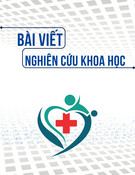
54
| Journal of Science and Technology in Medicine and Pharmacy | Vol 2, No 5 - 2023
Editor-in-Chief:
Dr. Nguyen Phuong Sinh
Received:
12/7/2023
Accepted:
11/9/2023
Published:
31/12/2023
Copyright: @ 2023
Belongs to the Journal of
Science and Technology in
Medicine and Pharmacy
Competing interests: The
authors have no competing
interests to declare.
Contact address: No. 284,
Luong Ngoc Quyen str., Thai
Nguyen city, Thai Nguyen
Province
Email:
tapchi@tnmc.edu.vn
THE CURRENT STATUS AND FACTORS RELATED TO
MENTAL HEALTH IN HIGH SCHOOL STUDENTS AT
TWO MOUNTAINOUS COMMUNES, THAI NGUYEN
PROVINCE
Hoang Trung Kien1, Ngo Xuan Long1*, Hoang Minh Huong1,
Le Thi Thu Hien2
1 Thai Nguyen University of Medicine and Pharmacy
2 Vinmec Phu Quoc General Hospital
* Author contact: xuanlong187@gmail.com
ABSTRACT
Background: Mental health in high school students plays a
pivotal role in shaping the foundation for learning and
development. Objective: this study is to describe the current
status and factors related to the mental health of high school
students two mountainous communes, Thai Nguyen Province.
Methods: The study was designed as a cross-sectional
descriptive study, involving a total of 400 high school students.
An anonymous survey was conducted from September to
Octorber 2021. The Strength and Dificulties Questionnaire
(SDQ) questionnaire for self-reporting by participant was used in
this study. Results: The research findings revealed that the group
of students with normal mental health status accounted for
67.5%, while those at the borderline level were 19.5%, and
13.4% of students were categorized as having abnormal mental
health. Factors related to the mental health of students included
their living area, family harmony, and academic stress (p<0.05).
Conclusions: A significant proportion of students (33.5%)
experiencing mental health challenges in this study. These results
underscore the importance of targeted interventions and support
systems to promote positive mental health outcomes among high
school students in similar contexts.
Keywords: High school students; Factor; Mental Health; Thai
Nguyen
INTRODUCTION
In 2016, the World Health Organization (WHO) released a report
indicating that mental and behavioral disorders in children and
adolescents were becoming increasingly prevalent, affecting

Journal of Science and Technology in Medicine and Pharmacy | Vol 2, No 5 - 2023 |
55
approximately 20% of children and adolescents worldwide. This
figure underscored the utmost importance of addressing the
psychological and emotional well-being of the younger
generations (World Health Organization, WHO - 2016)1.
In Vietnam, a nation with distinctive cultural and social
characteristics, research conducted by multiple authors has
identified the prevalent issues related to psychological and mental
health among Vietnamese students. These studies have
consistently shown that approximately 10-20% of students in
Vietnam are grappling with psychological and mental health
issues, necessitating attention, counseling, and therapeutic
interventions2-4. The detailed information about the
epidemiological situation of mental disorders in Vietnam can be
obtained from the epidemiological study conducted by Tran Van
Cuong. This study reported that 2.8% of the population exhibited
symptoms of depression, 2.6% showed signs of anxiety, and
behavioral disorders in adolescents accounted for 0.9% of the
population5.
The research overview suggests a scarcity of studies focusing on
mental health among high school students in the mountainous
districts of Thai Nguyen province. Consequently, our aim is to fill
this gap by providing valuable insights into the mental health
situation among high school students in Thai Nguyen Province.
Through our research, we aspire to offer essential guidance for
tailored support, interventions, and policy development in this
area. Our study seeks to illuminate the specific mental health
challenges faced by high school students in this region, with the
overarching goal of catalyzing improvements in mental health
services. This endeavor is crucial for fostering the overall
development and well-being of Vietnamese students. Our
primary objective is to assess the mental health status of high
school students in two selected mountainous communes in Thai
Nguyen Province and to identify factors associated with their
mental health.
METHODS
Study Participants, Time, and Location:
The study included high school students aged 12-16 years old
from April 2021 to December 2021 in Nam Hoa and Giang Tien

56
| Journal of Science and Technology in Medicine and Pharmacy | Vol 2, No 5 - 2023
moutainnous communes, Thai Nguyen province. The section
criteria as such: High school students, residence in mountainous
communes, willingness to participate and ability to understand
and complete the survey.
Methods
Study Design: A cross-sectional descriptive design was employed
for this study.
Sample Size and Sampling Method: Using a sample size
calculation based on proportions with a 95% confidence level, we
determined that 384 high school students were required to ensure
the study's accuracy. A convenient sampling method was utilized
in this research, and a total of 400 high school students who met
the sampling criteria participated in the study.
Instruments: This study utilized the Strength and Difficulties
Questionnaire (SDQ) questionnaire for self-reporting by children
(students). The questionnaire had been translated into Vietnamese
and validated for screening ability in the Vietnamese community
as part of the Ministry of Health's 2011 project6. The SDQ
questionnaire consists of 25 questions, including 10 about
strengths, 14 about weaknesses, and 1 neutral question. Each
statement had corresponding response levels: 0 – Not True, 1 –
Somewhat True, 2 – Certainly True. The questionnaire was
divided into 5 domains, each comprising 5 questions: 1)
Emotional Problems, 2) Conduct Problems, 3) Hyperactivity
Problems, 4) Peer Problems and 5) Prosocial Problems. Prosocial
Problems were scored positively (strengths), while the other four
domains (Emotional Problems, Conduct Problems, Hyperactivity
Problems, and Peer Problems) were scored negatively
(difficulties), and their scores were summed up.
Data Collection and Data Processing Method:
Data was collected using Google Forms and sent to students in the
selected communes. All students were provided with an
explanation of the research purpose and participated voluntarily.
Data Analysis: Data was entered and analyzed using EpiData 3.1 and
SPSS 20.0 software. The analysis included univariate statistics for

Journal of Science and Technology in Medicine and Pharmacy | Vol 2, No 5 - 2023 |
57
both quantitative and qualitative variables, and differences were
determined with a significance level set at p < 0.05.
Research ethics: The research was approved by the ethical
committee in the field of medical research at Thai Nguyen
University of Medicine and Pharmacy in 2021.
RESULTS
General charateristics
Table 1. General characteristics of the research participants
Characteristics
n
%
Age
≤ 14
185
46.25
> 14
215
53.75
Gender
Male
159
39.75
Female
241
60.25
Area
Urban
172
43.00
Rural
228
57.00
Ethnicity
Ethnic minority
183
45.75
Ethnic Kinh
217
54.25
The majority of high school students are female, accounting for
60.25% of the total. The proportion of students in rural areas is
higher than in urban areas (with a ratio of 57% compared to 43%).
More than half of the students belong to the Kinh ethnic group,
making up 54.25% of the population, while the remainder belong
to ethnic minority groups 45.75% (Table 1).
Mental Health Issues in High School Students
Table 2. Characteristics of Mental Health in Students in the Study
Scale
Normal
Borderline
Abnormal
Total Difficulty Score (0-40)
Score
0-15
16-19
20-40
n (%)
270 (67.50)
78 (19.50)
52 (13.00)
Emotional Problems (0-10)
Score
0-5
6
7-10
n (%)
277 (69.25)
46 (11.50)
77 (19.25)

58
| Journal of Science and Technology in Medicine and Pharmacy | Vol 2, No 5 - 2023
Conduct Problems (0-10)
Score
0-3
4
5-10
n (%)
312 (78.00)
59 (14.75)
29 (7.25)
Hyperactivity Problems
(0-10)
Score
0-5
6
7-10
n (%)
328 (82.00)
39(9.75)
33 (8.25)
Peer Problems (0-10)
Score
0-3
4-5
6-10
n (%)
252 (63.00)
121 (30.25)
27 (6.75)
Prosocial Problems (10-0)
Score
0-3
4-5
6-10
n (%)
322 (80.50)
60 (15.00)
18 (4.5)
Table 2 showed that the majority of high school students
(67.50%) fall within the normal range, while 19.50% are
borderline and 13.00% are categorized as having abnormal mental
health. A significant portion of students (69.25%) report normal
levels of emotional problems. There are 14.75% falling into the
borderline range and 7.25% categorized as having abnormal
conduct. The majority of students (82.00%) report normal levels
of hyperactivity, while 9.75% are borderline and 8.25% are
categorized as having abnormal hyperactivity. In addition, there
are 30.25% are borderline and 6.75% are categorized as having
abnormal peer relationships. The majority of students (80.50%)
exhibit normal prosocial behavior, while 15.00% fall into the
borderline range and 4.5% are categorized as having abnormal
prosocial behavior.
Factors Influencing the Mental Health of High School
Students
Table 3. Average Scores by Student’s Characteristics
Characteristics
Mental Health
Normal
Borderline
Abnormal
p
Living
Area
Urban
111 (64.25)
43 (25.25)
18 (10.50)
0.026
Rural
148 (69.00)
46 (15.25)
34 (15.75)
Harmony
in the
Family
Harmonious Family
120 (68.50)
34 (19.50)
21 (12.00)
0.007
Non-Harmonious
Family
147 (65.25)
44 (19.75)
34 (15.00)
Academic
Stress
No Stress
140 (65.25)
51 (24.00)
23 (10.75)
0.018
Stressful
123 (68.50)
29 (16.25)
27 (15.25)






















![Bài giảng Cập nhật vấn đề hồi sức bệnh tay chân miệng nặng [mới nhất]](https://cdn.tailieu.vn/images/document/thumbnail/2025/20250920/hmn03091998@gmail.com/135x160/23301758514697.jpg)



